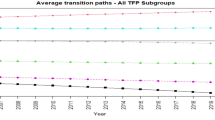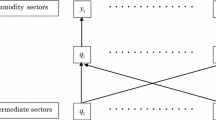Abstract
The purpose of this paper is to highlight the weakness of innovative activities and guide the improvement of innovation efficiency at country-level through carefully comparing innovation efficiency across countries. Following the conceptual framework which divides innovation processes into knowledge production process (KPP) and knowledge commercialization process (KCP) and applying dual network-DEA models, this paper tries to take economic benefit of R&D outputs into account. Moreover, we construct the production frontier of the innovation processes and two component processes under different assumptions (e.g., constant returns-to-scale, variable returns-to-scale and non-increasing returns-to-scale) for 35 countries over the period 2007–2011. Based on the production frontier, we do not only estimate technical efficiency and scale efficiency for each country but also investigate and verify whether returns-to-scale of each country are decreasing or increasing. Furthermore, we add together the radial movement and the slack movement to acquire input redundancy. We decompose the input redundancy into two parts: redundancy caused by technical inefficiency (R_TI) and redundancy caused by scale inefficiency (R_SI), and carry out a detail analysis of the input redundancy. We find specific circumstances of inefficiency and redundancy vary with the different countries’ characteristics and development stages. Moreover, innovation efficiency statistically mainly depends on the KCP efficiency. In particular, the study reveals that China suffers scale inefficiency is attributed to insufficient macro-level coordination, malfunctioning funding system, and flawed evaluations and incentives. Finally, public policy implications are proposed for the inefficient countries.

Similar content being viewed by others
Notes
Redundancy = Radial movement + Slack movement. The detailed definition of redundancy is proposed in “Efficiency analysis“ section.
Redundancy = Radial movement + Slack movement. The detailed definition of redundancy is provided in “Efficiency analysis“ section.
Datasource: OECD-MSTI. GERD is measured in million USD at the price of 2012 based on purchasing power parities (PPP).
LGSTE is an affiliate of the State Council.
References
Abramo, G., D’Angelo, C. A., & Pugini, F. (2008). The measurement of Italian universities’ research productivity by a non parametric-bibliometric methodology. Scientometrics, 76(2), 225–244.
Banker, R. D., Charnes, A., & Cooper, W. W. (1984). Some models for estimating technical and scale inefficiencies in data envelopment analysis. Management Science, 30(9), 1078–1092.
Bonaccorsi, A., & Daraio, C. (2005). Econometric approaches to the analysis of productivity of R&D systems. In H. F. Moed, W. Glänzel, & U. Schmoch (Eds.), Handbook of quantitative science and technology research (pp. 51–74). Berlin: Springer.
Bonaccorsi, A., Daraio, C., & Simar, L. (2006). Advanced indicators of productivity of universitiesAn application of robust nonparametric methods to Italian data. Scientometrics, 66(2), 389–410.
Cao, C., Li, N., Li, X., & Liu, L. (2013). Reforming China’s S&T system. Science, 341(6145), 460–462.
Charnes, A., & Cooper, W. W. (1962). Programming with linear fractional functionals. Naval Research Logistics Quarterly, 9(3–4), 181–186.
Charnes, A., & Cooper, W. W. (1984). The non-Archimedean CCR ratio for efficiency analysis: A rejoinder to Boyd and Färe. European Journal of Operational Research, 15(3), 333–334.
Charnes, A., Cooper, W. W., & Rhodes, E. (1978). Measuring the efficiency of decision making units. European Journal of Operational Research, 2(6), 429–444.
Charnes, A., Cooper, W. W., & Rhodes, E. (1979). Short communication: Measuring the efficiency of decision-making units. European Journal of Operational Research, 3(4), 339.
Chen, Y., Cook, W. D., Li, N., & Zhu, J. (2009). Additive efficiency decomposition in two-stage DEA. European Journal of Operational Research, 196(3), 1170–1176.
Chen, C. P., Hu, J. L., & Yang, C. H. (2013). Produce patents or journal articles? A cross-country comparison of R&D productivity change. Scientometrics, 94(3), 833–849.
Choung, J.-Y., & Hwang, H.-R. (2013). The evolutionary patterns of knowledge production in Korea. Scientometrics, 94(2), 629–650.
Coelli, T. J. (1995). Recent developments in frontier modelling and efficiency measurement. Australian Journal of Agricultural and Resource Economics, 39(3), 219–245.
Cohen, W. M., & Levinthal, D. A. (1990). Absorptive capacity: A new perspective on learning and innovation. Administrative Science Quarterly, 35(1), 128–152.
Cook, W. D., Liang, L., & Zhu, J. (2010). Measuring performance of two-stage network structures by DEA: A review and future perspective. Omega, 38(6), 423–430.
Crespi, G. A., & Geuna, A. (2008). An empirical study of scientific production: A cross country analysis, 1981–2002. Research Policy, 37(4), 565–579.
Cruz-Cázares, C., Bayona-Sáez, C., & García-Marco, T. (2013). You can’t manage right what you can’t measure well: Technological innovation efficiency. Research Policy, 42(6–7), 1239–1250.
Dvir, R., & Pasher, E. (2004). Innovation engines for knowledge cities: An innovation ecology perspective. Journal of Knowledge Management, 8(5), 16–27.
Edquist, C. (1997). Systems of innovation. London: Frances Pinter.
Färe, R., Grosskopf, S., & Logan, J. (1983). The relative efficiency of Illinois electric utilities. Resources and Energy, 5(4), 349–367.
Färe, R., Grosskopf, S., & Logan, J. (1985). The relative performance of publicly-owned and privately-owned electric utilities. Journal of Public Economics, 26(1), 89–106.
Farrell, M. J. (1957). The measurement of productive efficiency. Journal of the Royal Statistical Society, 120(3), 253–290.
Førsund, F. R., Lovell, C. A., & Schmidt, P. (1980). A survey of frontier production functions and of their relationship to efficiency measurement. Journal of Econometrics, 13(1), 5–25.
Freeman, C., & Soete, L. (1987). The economics of industrial innovation. Cambridge, MA: The MIT Press.
Furman, J. L., Porter, M. E., & Stern, S. (2002). The determinants of national innovative capacity. Research Policy, 31(6), 899–933.
Geisler, E. (1995). An integrated cost-performance model of research and development evaluation. Omega, 23(3), 281–294.
Griliches, Z. (1990). Patent statistics as economic indicators: A survey. Journal of Economic Literature, 20, 1661–1707.
Guan, J. C., & Chen, K. H. (2010a). Measuring the innovation production process: A cross-region empirical study of China’s high-tech innovations. Technovation, 30(5), 348–358.
Guan, J. C., & Chen, K. H. (2010b). Modeling macro-R&D production frontier performance: An application to Chinese province-level R&D. Scientometrics, 82(1), 165–173.
Guan, J. C., & Chen, K. H. (2012). Modeling the relative efficiency of national innovation systems. Research Policy, 41(1), 102–115.
Guan, J. C., Yam, R., Mok, C. K., & Ma, N. (2006). A study of the relationship between competitiveness and technological innovation capability based on DEA models. European Journal of Operational Research, 170(3), 971–986.
Guellec, D., & Van Pottelsberghe, B. (2001). R&D and productivity growth: Panel data analysis of 16 OECD countries. OECD Economic Studies, 2001(2), 103–126.
Hagedoorn, J., & Wang, N. (2012). Is there complementarity or substitutability between internal and external R&D strategies? Research Policy, 41(6), 1072–1083.
Han, Y.-J. (2007). Measuring industrial knowledge stocks with patents and papers. Journal of Infometrics, 1(4), 269–276.
Hasan, I., & Tucci, C. L. (2010). The innovation-economic growth nexus: Global evidence. Research Policy, 39(10), 1264–1276.
Ho, M. H.-C., & Liu, J. S. (2013). The motivations for knowledge transfer across borders: The diffusion of data envelopment analysis (DEA) methodology. Scientometrics, 94(1), 397–421.
Hollanders, H., & Celikel-Esser, F. (2007). Measuring innovation efficiency INNO Metrics 2007 report. Brussels: European Commission, DG Enterprise.
Hung, W.-C., Lee, L.-C., & Tsai, M.-H. (2009). An international comparison of relative contributions to academic productivity. Scientometrics, 81(3), 703–718.
Jiménez-Sáez, F., Zabala-Iturriagagoitia, J. M., & Zofío, J. L. (2013). Who leads research productivity growth? Guidelines for R&D policy-makers. Scientometrics, 94(1), 273–303.
Jun, S. P., Seo, J. H., & Son, J. K. (2013). A study of the SME technology road mapping program to strengthen the R&D planning capability of Korean SMEs. Technological Forecasting and Social Change, 80(5), 1002–1014.
Kao, C., & Hwang, S.-N. (2008). Efficiency decomposition in two-stage data envelopment analysis: An application to non-life insurance companies in Taiwan. European Journal of Operational Research, 185(1), 418–429.
Kim, Y. K., Lee, K., Park, W. G., & Choo, K. (2012). Appropriate intellectual property protection and economic growth in countries at different levels of development. Research Policy, 41(2), 358–375.
King, D. A. (2004). The scientific impact of nations. Nature, 430(6997), 311–316.
Lucas, R. E. (1988). On the mechanics of economic development. Journal of Monetary Economics, 22(1), 3–42.
Lundvall, B. Å. (2007). National innovation systems—Analytical concept and development tool. Industry and Innovation, 14(1), 95–119.
Moon, H. S., & Lee, J. D. (2005). A fuzzy set theory approach to national composite S&T indices. Scientometrics, 64(1), 67–83.
Nelson, R. R. (1982). The role of knowledge in R&D efficiency. The Quarterly Journal of Economics, 97(3), 453–470.
OECD. (2008). OECD reviews of innovation policy China. (pp. 87–93). Paris.
Oxman, J. A. (1992). The global service quality measurement program at American Express Bank. National Productivity Review, 11(3), 381–392.
Revilla, A. J., & Fernández, Z. (2012). The relation between firm size and R&D productivity in different technological regimes. Technovation, 32(11), 609–623.
Romer, P. M. (1986). Increasing returns and long-run growth. The Journal of Political Economy, 94(5), 1002–1037.
Romer, P. M. (1990). Endogenous technological change. Journal of Political Economy, 98(5), S71–S102.
Rossi, F., & Emilia, U. M. R. (2002). An introductory overview of innovation studies. MPRA Working Paper No. 9106.
Rousseau, S., & Rousseau, R. (1997). Data envelopment analysis as a tool for constructing scientometric indicators. Scientometrics, 40(1), 45–56.
Rousseau, S., & Rousseau, R. (1998). The scientific wealth of European nations: Taking effectiveness into account. Scientometrics, 42(1), 75–87.
Schwab, K. (2012). The global competitiveness report 2012–2013. Geneva: World Economic Forum.
Sharma, S., & Thomas, V. (2008). Inter-country R&D efficiency analysis: An application of data envelopment analysis. Scientometrics, 76(3), 483–501.
Shi, Y. G., & Rao, Y. (2010). China’s research culture. Science, 329(5996), 1128.
Souza, G. S., Alves, E., & Avila, A. F. D. (1999). Technical efficiency of production in agricultural research. Scientometrics, 46(1), 141–160.
Stuart, T. E., Ozdemir, S. Z., & Ding, W. W. (2007). Vertical alliance networks: The case of university-biotechnology-pharmaceutical alliance chains. Research Policy, 36, 477–498.
Wong, C.-Y. (2013). On a path to creative destruction: Science, technology and science-based technological trajectories of Japan and South Korea. Scientometrics, 96(1), 323–336.
Acknowledgments
This study is supported by a grant from National Natural Science Foundation of China (No. 71373254). The authors are very grateful for the valuable comments and suggestions from the anonymous reviewers and Editor-in-Chief of the journal, which significantly improved the quality and readability of the paper. We also thank Dr. Kaihua Chen for his benefit discussion.
Author information
Authors and Affiliations
Corresponding author
Additional information
The authors’ names are alphabetically ordered and they contributed equally to this paper.
Rights and permissions
About this article
Cite this article
Guan, J., Zuo, K. A cross-country comparison of innovation efficiency. Scientometrics 100, 541–575 (2014). https://doi.org/10.1007/s11192-014-1288-5
Received:
Published:
Issue Date:
DOI: https://doi.org/10.1007/s11192-014-1288-5




